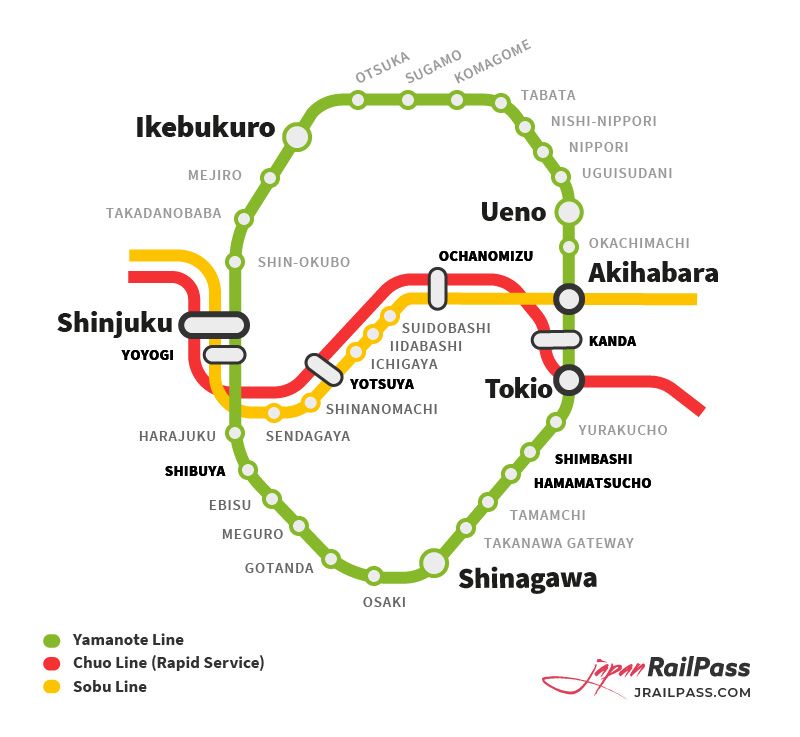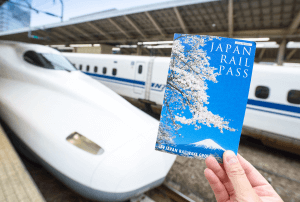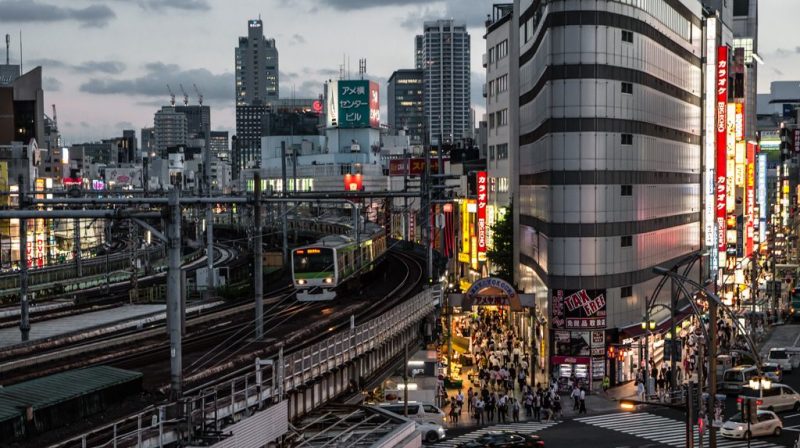The JR Yamanote line, operated by JR East, is probably the most popular and convenient way for getting around Tokyo.
At 34,5 km (21,44 miles) long, this is the only line that connects all of Tokyo’s most famous central stations. It’s also known as the Tokyo green line because of the color of its trains and the green color used to outline its route on maps.
JR Pass holders can take advantage of this loop service for free. Taking any train on the Yamanote line is fully included in the JR Pass.
Read on for our complete guide to the Yamanote line.
Table of Contents
Yamanote line map
On the map below, you can find the Yamanote line marked in green, with the major stations indicated in bold.

Yamanote line schedule
The Yamanote line trains run from 4:26 am to 1:20 am the next day, but the exact times of the first and last service depends on the station.
During rush hour, trains run every 2 and a half minutes.
The off-peak standard waiting time for a train on the Yamanote line is every 3.5 to 4 minutes.
On December 31 and January 1, times may differ. For more detailed information on the Yamanote line’s timetables, check out Japan Transit Planner.
Traveling all the way around the line full circle will take you approximately 1 hour. All the Yamanote line trains stop at every station.
All Japanese trains, buses, trams and metro lines are extremely punctual.
The longest delays tend to be no more than 5 minutes. If this happens, you’ll likely hear a sincere apology on the speakers.


Unlimited access to transportation across Japan for 7, 14, or 21 days on:
- All Shinkansen trains
- Rapid and Local JR trains
- JR bus and ferry services
- Airport Transfers
A single ticket, huge savings.
Yamanote line stations
The JR Yamanote line is a circular line that includes many stops throughout Tokyo. These include most of the city’s main train stations.
Here is a list of the principal stations served by the Yamanote line:
- JR Shinjuku Station: Thought to be the world’s busiest train hub, with over 3 million passengers passing through the station every day. Here you can transfer to the Narita Express to Narita Airport, as well as other lines.
- JR Yoyogi Station: Situated between the north entrance of the Meiji Shrine, part of the Yoyogi Park, and the Shinjuku Gyoen National Garden.
- JR Harajuku Station: The gateway to Harajuku district, perfect for shoppers.
- JR Shibuya Station: Famous for the busiest intersection in the world – the Shibuya crossing.
- JR Meguro Station: The station for the quiet and residential area of Ebisu and Meguro.
- JR Shinagawa Station: Provides connection with the Tokaido Shinkansen line. In the future, it will also be the terminus of the Chuo Shinkansen.
- JR Takanawa Gateway Station: The newest station on the Yamanote line, opened in March 2020, is also served by the Keihin Tohoku Line.
- JR Tokyo Station: The central station, as well as a terminal station for all Shinkansen bullet trains.
- JR Akihabara Station: One of the largest Tokyo Metro stations, has direct connections with numerous other lines.
- JR Ueno Station – All Shinkansen trains that go to the north of Japan stop at this station.
And below is a list of all the Yamanote line stations, counter-clockwise:
- North side: Nippori – Nishi-Nippori – Tabata – Komagome – Sugamo – Otsuka – Ikebukuro – Mejiro
- West side: Takadanobaba – Shin-Okubo – Shinjuku – Yoyogi – Harajuku – Shibuya – Ebisu – Meguro – Gotanda
- South side: Osaki – Shinagawa – Takagawa Gateway– Tamachi – Hamamatsucho – Shimbashi – Yurakucho
- East side: Tokyo – Kanda – Akihabara – Okachimachi – Ueno – Uguisudani
Connections with other lines
Finally, here is the list of all important connections to other lines which you can ride for free with the JR Pass:
- Chuo line: Shinjuku station, Yotsuya station, Ochanomizu station, Kanda Station and Tokyo station
- Narita Express (to Narita Airport): Tokyo Station, Hamamatsucho, Shinagawa, Shibuya,Shinjuku, Ikebukuro
- Tokyo Monorail (to Haneda Airport): Hamamatsucho Station
- Keihin-Tohoku line: Ueno station, Tokyo station, and Shinagawa station.
- Sobu line – Runs across the Yamanote line, similar to the Chuo line. However, it is the slower one of the two.
- Saikyo line – Osaka station, Ebisu station, Shibuya station, Shinjuku station, Ikebukuro station
